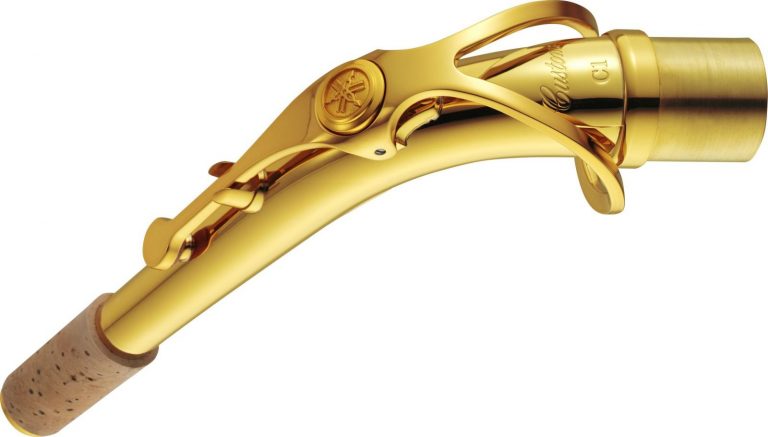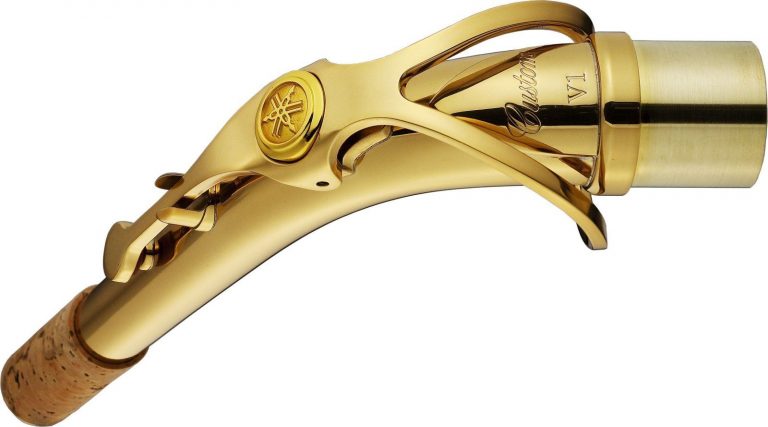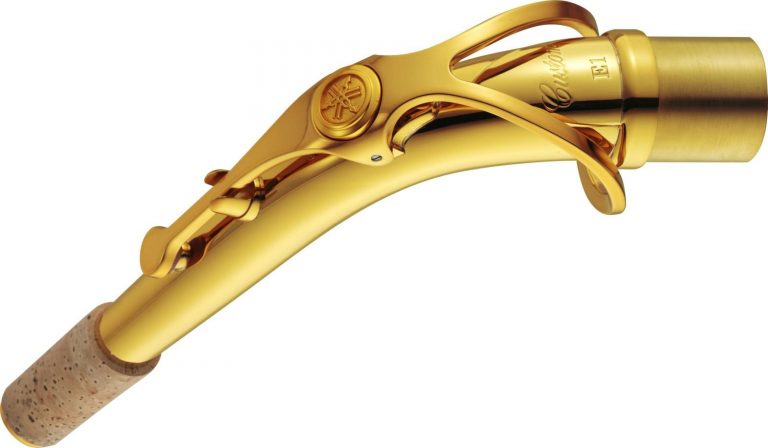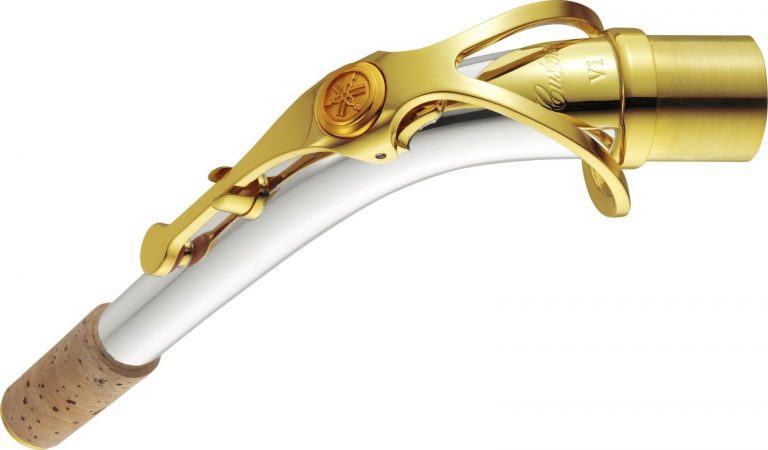Yamaha Custom Saxophone Necks
Yamaha Custom Saxophone-Necks
Reed, mouthpiece and neck have the greatest influence on the sound of a saxophone. What the listener perceives is primarily created in the mind of the musician, his sound concept prevails. Nevertheless, the selection of material supports the work of the instrumentalist.
The sound of the saxophone develops in the musician’s oral cavity: inside it is the mouthpiece, here the air flow sets the reed in vibration. Since the physical characteristics of the musicians are never identical, the same reed or mouthpiece always sounds a little different, depending on who is blowing it. You have to keep this fact in mind when writing or reading about reeds, mouthpieces, necks and the like. Recordings reflect only the respective relationship between material and musician, but never universally determined characteristics of the equipment.
The saxophone neck represents the most important link between the mouthpiece and the reed on one hand and the body of the instrument on the other. The bore course, material and structure of the neck, its geometry, determine the acoustic properties of the neck and significantly color the sound. By choosing a specific neck, the saxophone gets its characteristics – the basic sound. There are necks with lower or higher blowing resistance.
However, the strength of this resistance says little about the quality of the neck in question. The respective blowing resistance is a characteristic that the musician is looking for, according to his own preference and sound idea, and which he consciously chooses.
Some renowned manufacturers offer different necks for their saxophone models. Yanagisawa, for example, has been producing necks from several materials and with a range of boreholes for decades. There are a number of smaller companies that mainly produce necks in the best tradition of craftsmanship. Among the more well-known workshops, the following should be mentioned: Bösken, Forestone, Gloger, Inderbinen, KB-Necks, Schucht.
Yamaha has also been producing various necks for its saxophone models for several years, using changing model names and designs: the so-called custom saxophone necks.
Currently, in March 2022, Yamaha offers three necks, in brass or solid silver and in four surfaces: unpainted, gold lacquer finish, silver-plated and gold-plated. The necks basically differ in the course of their boreholes: the so-called V1, E1 and C1 necks stand for a wide, middle and narrower bore course, respectively.
Yamaha explains:
„The V1 neck has the largest borehole of all Yamaha Custom necks. It is very open and free, offers a large dynamic spectrum and a robust sound with an abundance of overtones. The E1 neck with a medium bore is easy to control, offers a quick response and an excellent timbre. This versatile neck is perfect for musicians who can play their individual sound owing to its flexibility. The C1 neck has the smallest bore of all Yamaha Custom necks. It is easy to control and responds quickly. It offers a slightly darker timbre and a robust tone. Due to the large dynamic spectrum and the increased flexibility, the sterling silver necks give the instrument a more lively sound.“




I have the complete set of these Yamaha Custom necks. Over the last few years, I have gradually acquired the individual necks and use them on my Yamaha 82Z WOF UL and 875EX Alto and tenor saxophones.
The afore-mentioned explanation of the company Yamaha aptly describes the characteristics of the respective necks. However, I would like to add a few comments and explanations. First of all: all necks are handmade at the highest level of excellence, as are the above-mentioned saxophones from this manufacturer!
The curvatures of the necks are chosen in such a way that musician’s head and chin are in a completely horizontal position. While blowing, such a posture creates an open position of the pharynx and the larynx: it supports a sonorous sound and safe intonation control.
The wall thickness of all necks is at a medium level. The response of the necks is fast and direct. The differences between the necks are by no means enormous in this regard: the open V1 absorbs a little more air, while its blowing resistance is slightly lower than that of the narrower C1. In principle, however, the following applies: all necks presented here do not require increased physical effort. The differences in blowing resistance are noticeable, but not pushing to the foreground. The sound control is easy, as the blowing resistance is quite low, but still giving enough support to enable a safe sound design.
Moreover, the necks share an extremely wide dynamic range: the V1 does not sound louder than the C1 or E1. All necks are suitable for filling the largest hall with a powerful sound even without using microphones. These necks are present! The V1 is massive in sound, very open and round, extremely voluminous. The C1 is denser, bundled, in a sense more compressed. The E1 is located exactly in the acoustic center between the V1 and C1.
In fact, intonation, timbre and sound definition vary with respect to the different boreholes: the V1 demands higher concentration to achieve a balanced intonation. This neck does not play badly out of tune, but due to its flexibility, intonation in the higher and lower ranges is more likely to break out when the attention and control of the musician subside. A note on this point: the intonation attitude of a saxophone depends significantly on the ratio between the borehole of the neck and that of the mouthpiece used. The choice of the reed also influences the intonation attitude. With a suitable mouthpiece, the intonation control of the V1 neck can be stabilized quite a bit: using the Theo Wanne Gaja or Ambika, two mouthpieces of larger chamber, I achieve fine results in this regard. Casual Legere Signature synthetic reeds also play precisely in tune.
The C1 enables the most balanced intonation: the tones start very exactly at the correct pitch and are extremely stable: this neck really plays excellently well in tune! The E1 lies between the V1 and C1 in terms of intonation attitude: it offers flexibility and still plays reliably and quite balanced.
While the V1 provides a large, wide, very brilliant tone, without sounding hollow, harsh or tinny, the E1 and even more the C1 neck allow a darker, very colorful sound with a much more complex coloration and timbre. The tighter drilled E1 and C1 necks not only play more balanced in tune, but they define the tone more precisely, resulting in a more focused and contoured sound.
While all three necks are equally comfortable to blow, offering comparable volumes and corresponding dynamic spans, they differ above all in volume, coloration and intonation attitude. The described differences in the boreholes refer to the course of the hole: it is about the way in which the respective neck gradually widens and opens from its inlet to the plug-in sleeve. The geometry of the hole defines the properties.
The volume of the necks, the width of their boreholes, results from the respective course: the V1 has an almost uniformly conical, more linear borehole course, which results in a larger volume. The C1 and also the E1 have a much flatter and thus narrower bore course in its front third: the cone of the neck expands more clearly only in the second third of the borehole,
leading to the smaller volumes of these two necks. This is similar to saxophone mouthpieces: besides the facing, not only the size of the chamber but also its shape influence the responsiveness, tuning and sound.
The quality of the three necks is at the highest level. The differences between them can be found less in the response, but rather in the intonation attitude, sound volume, sound structure, coloration and timbre. The definition of the tone differs. Switching between the necks is quite easy and therefore makes it possible to give the basic sound of a Yamaha 82Z or 875EX a different timbre or sound design with basically very similar playing behavior. By using one of the three necks, a Yamaha Model 62 gains considerable format, in particular sound quality. Provided that the dimensions of the shaft and the neck-fastening sleeve are compatible, it is possible to mount these necks on saxophones from some other manufacturers: the Selmer Super Action 80 Series II tenor saxophone sounds remarkable in combination with a Yamaha Custom V1 neck! Experiments are worthwhile!
I personally prefer the E1 and C1 necks, as I strive for a more complex, defined and focused sound with fine coloration and timbre. In addition, the more stable and precise intonation of both necks is highly convincing. In my view, the E1 neck represents the most successful compromise between flexibility, coloration or timbre, and precise intonation. If you jump back and forth between musical genres more often, the E1 neck or the alternating use of the V1 and C1 necks can be recommended.